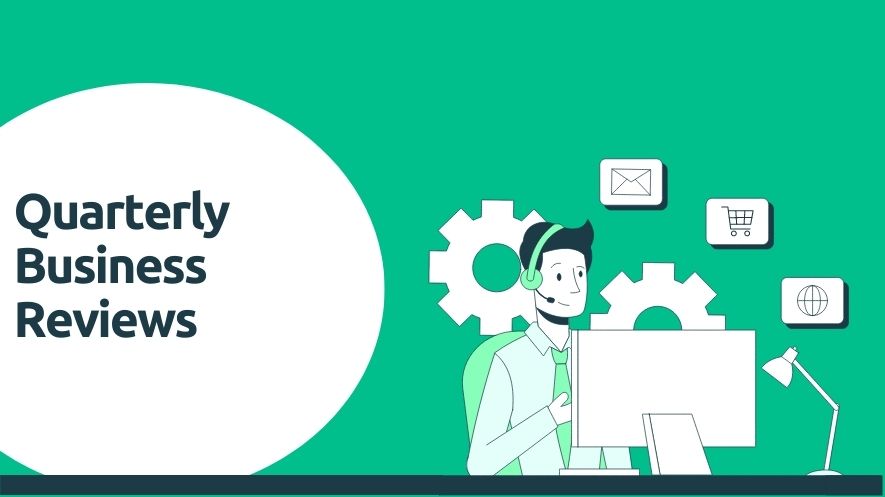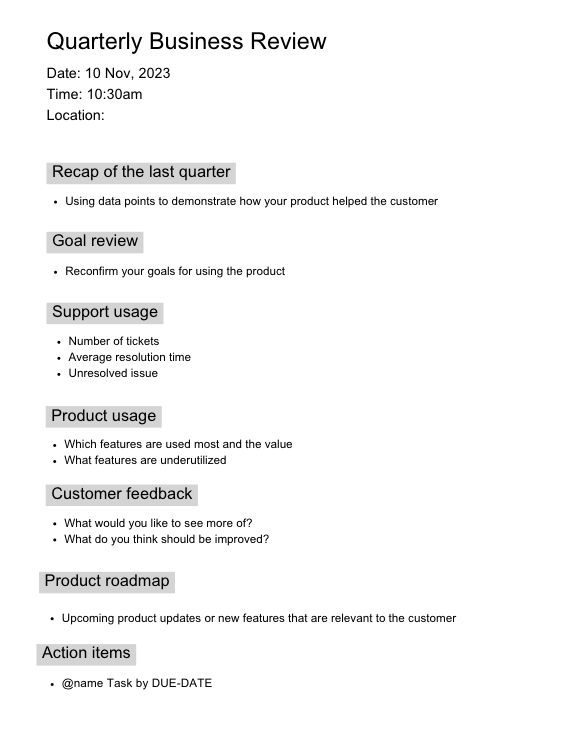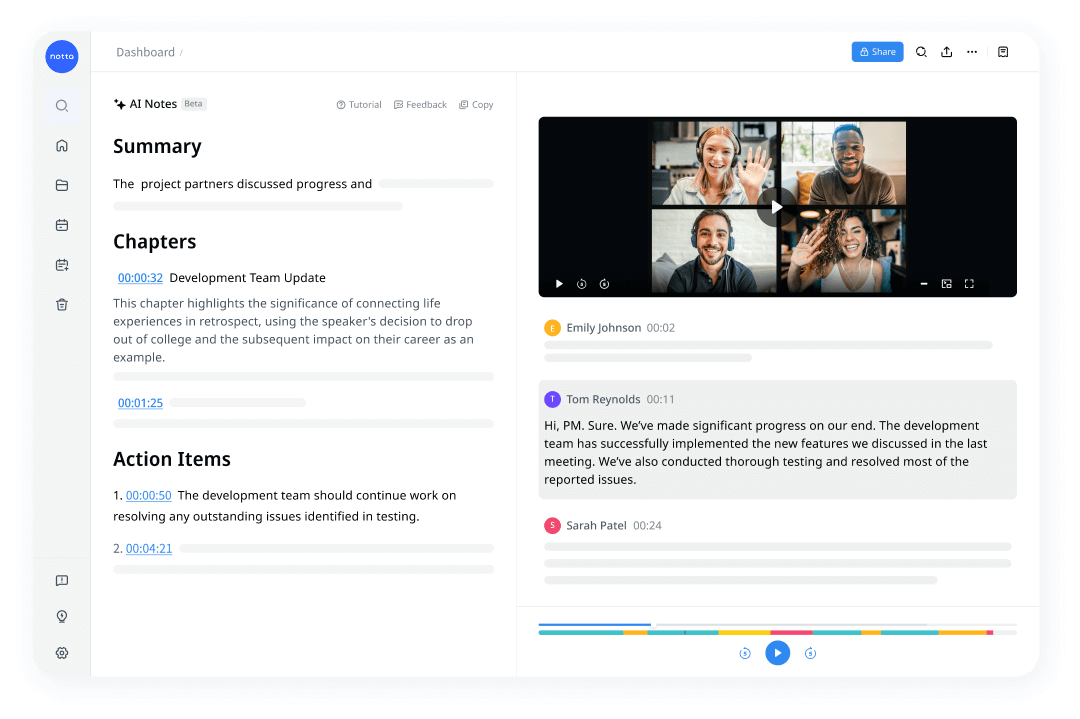
How to Run a Quarterly Business Review? [+Agenda Template]
Unlock the power of AI — Notta's meeting assistant records, transcribes and summarizes meeting minutes with one click.
Quarterly business review (QBR) is a powerful framework that enables companies to maintain good customer relationships and provide vital insights for improving their products.
Given its importance, many customer success managers feel unconfident before the review meeting, worrying that they may not meet customers’ needs or even break the relationship.
So in this post, we'll cover everything you need to know about running an engaging quarterly business review meeting. We'll look at some best practices while reviewing an example agenda you can implement today.
What is a quarterly business review (QBR)?
A quarterly business review is a meeting held once per quarter with customers to discuss the value your product and/or services add to their business.
The primary goal of a QBR is to showcase the role you play in your customers’ success. Effective quarterly business reviews keep customers excited about your product, help them achieve bigger things, and provide you with valuable insights for improving customer experiences.
Types of QBR meetings
1. Onboarding meeting
With onboarding meetings, you're sitting down with customers who just signed up and helping them learn how to use your product to its full potential. You're also getting an idea of the pain point behind why they signed up, allowing you to optimize marketing campaigns.
2. Pre and post-renewal meeting
Businesses that offer a subscription service run pre and post-renewal meetings with customers every quarter. They'll ask questions like:
How has our product empowered your life?
What part of our product would you like to see us improve?
Why did you choose us over the competition?
This strengthens relationships with customers and helps you understand product limitations.
3. Exit meetings
During such meetings, you sit down with customers who canceled their subscriptions and try to find out what led them to that decision. Maybe the interface is cluttered, or customer success didn't ensure they used the tool to its full potential.
If you see a specific problem popping up multiple times, you'll want to fix it since it's costing customers.
Why should you conduct quarterly business reviews?
We touched on the importance of running QBRs in the previous section, here we’ll further explain the benefits.
Foster strong relationships
Having quarterly meetings with clients shows you care about their needs. This way, you aren't viewing customers as one-off deals. Instead, it's a long-term partnership that ensures continual growth on both sides.
Get quality feedback about the product
By listening to customers about what they like and dislike about your product, the PM team can make continued improvements.
So instead of stagnating or introducing upgrades customers don't need, you'll be able to use real-life feedback to better the user experience.
Keep track of progress made
It's easier to keep track of progress when having meetings regularly. Use the notes from your last meeting to see how your product improved.
It's also important to consult your customers about changes made over the last three months and find out if it's positively impacting their work processes.
Acts as an early warning
A sudden increase in customer churn rate surprises many companies.
But it doesn’t happen overnight. These customers suffer in silence because your product isn't meeting their needs. And after a few months, they’ll cancel their subscription. Without QBR meetings, it's almost impossible to pick up on this.
Quarterly meetings act as an early-warning system that lets you adapt. If you notice a pattern of customer problems, you still have time to fix it before your churn rate increases.
Notta offers the most integrated AI meeting notes, summaries, and action items so nothing gets missed.
What should you include in a QBR agenda?
You should tailor every quarterly business review to the customer in question but each QBR agenda wants to include the following:
Recap of the last quarter
This is where you discuss the wins and misses over the previous quarter. Focus on your customer’s goals and KPIs, using data reports to show how valuable actions in your product generate ROI for them.
Goal review
Re-confirm your customer’s goals - including the relevant metrics and KPIs - and discuss any changes since the previous QBR.
Support usage
Analyze the number of tickets submitted by the customer, the resolution time, and any unresolved issues. Each ticket can be seen as a red flag in your user’s experience.
However, if the customer hasn’t asked for support at all, it may suggest they aren’t using your product frequently and you need to dig out the reason.
Product usage
Analyze the customer’s use of your product and how it’s helping them to achieve their goals. Discuss the features they’re getting the most value from and the ones they’re underutilizing in your product that could help them do even better.
Customer feedback
Allow the customer to explain what they feel is going well and what could be improved. Encourage them to keep a log of feedback every quarter so they know what they want to discuss in the next QBR.
If they raise any new issues, you can tell them how to proceed - eg, replicating the problem and providing technical info to help you resolve it.
Product roadmap (optional)
If your roadmap for the next quarter includes any updates or new features that could benefit the customer, now is a good time to show them. Likewise, you may want to mention anything further down the line on your roadmap that’s relevant to feedback or issues raised during the QBR meeting.
Action items and summary
Summarize the entire meeting and assign action items to your team so they know what to do after the QBR is finished.
[An example QBR template]

How to run a successful quarterly business meeting?
Now you’ve got a ready-to-use QBR agenda template in hand, let’s explore the tips for making your next QBR meeting a success.
1. Analyze the customer
Each customer has unique needs and expectations of your product and services. They could be at different stages of the customer cycle, too, with varying levels of satisfaction. Some will also use your product more than others and show more likelihood of upgrading or renewing at the end of their current subscription period.
Profile each customer before holding a quarterly business review, analyze customer health scores, and make sure everything in your agenda is 100% relevant to them.
2. Collect data
Data should do most of the talking for you in QBR meetings. You want to prove the value of your product by attributing customer actions in your software to goal completions and KPIs. Analyze the sessions where customers are getting the most out of your product and show them how they can do this more often.
The challenge is crafting an engaging story with this data. Don’t bombard customers with numbers; create a narrative with data visualizations centered around their goals and KPIs.
3. Prioritize the client's goals
The golden rule to running a productive QBR meeting is to prioritize the client's business goals. Your entire QBR should be relevant to the goals of your customers because it keeps them engaged. If a particular topic isn’t relevant, there's no reason to include it. It'll just distract you from what matters.
So when writing a QBR meeting agenda, ask yourself if the subtopics help clients reach their goals. This ensures you stay on track.
If it's your first QBR meeting with a client, ask about their business objectives after the introduction. This allows you to base the rest of the meeting on how you can help them achieve this goal.
4. Highlight wins & opportunities
You have to prove to customers that your product adds significantly more value to their lives than the monthly subscription fees they’re paying.
This starts with highlighting the wins in every QBR to show your product consistently delivers. Next, you can ramp up the motivation by showing forecasts of even bigger wins if they use your product differently. Finally, you have to be honest about losses and issues customers raise but you can approach these as opportunities to get even better results.
5. Stick to the agenda
Make sure you stick to the agenda during your QBR meetings. Work through the items on your agenda, one by one, and keep the conversation relevant to each point. You’ve added time slots for each topic and it’s important to stay on schedule.
If anyone raises anything important that’s not on the agenda or any topics overrun, make a note and move on. You can arrange a separate discussion outside of the QBR with anyone who wants to talk about something else.

6. Keep it conversational
QBR meetings are not presentations, so don’t do all the talking yourself. Give your customers plenty of opportunities to ask questions, raise concerns, and provide feedback throughout the meeting - and allow time for this in your agenda.
As a general rule, everyone attending the meeting should have their chance to speak - otherwise, you have to question why you invited them.
Also, make sure you genuinely listen and make customers feel heard.
With Notta, you can easily generate meeting minutes, turning spoken content into written records with 98.86% accuracy.
Tips for writing a quarterly business report
Giving each customer a quarterly business report as part of your QBR gives them a copy of the key points raised in your meeting. This allows them to go away, organize their thoughts, and revisit the takeaways from your quarterly business reviews.
It also helps you reinforce the core messages of your meeting and the data points showcasing the value of your product. Here are some tips to help you create more effective quarterly business reports.
Tell the story with data
The best QBR reports use data to prove the value of a product but numbers alone won’t excite your customers. You have to craft a compelling story with the data to keep them motivated. Even by following the most basic elements of storytelling (beginning, middle, and end), you can start to build a compelling narrative.
Remind customers what life was like before your product (beginning), how much it has improved with your product (middle), and how bright the future looks together (happy ever after).
Bring the story to life with data visualizations
You can’t tell much of a story with spreadsheets but you can capture the imagination of customers by bringing your report to life with data visualizations.
With a single graph, you can show customers how much their KPIs have improved over the past 90 days compared to previous quarters - and what performance could look like in the next quarter if they follow your advice.
Use QBR report templates
Creating reports for every QBR takes a lot of time so use branded templates to speed this process up. This also helps maintain consistency and you can also create templates for graphs and other data visualizations - for example, ROI graphs, monthly usage stats, etc.
Add personal touches to your QBR reports
Personalize each report to include the customer’s company name where relevant. Depending on how many people are going to receive your report, you may also include the names of the contacts you’re sending them to - as long as this isn’t going to exclude anyone.
Wrap it up with recommendations & next steps
End the report with recommendations that will help your customer get even better results from your product. Refer back to any advice provided during the QBR and relevant data to back up your suggestions, especially any forecasts used to show potential performance.
Also, confirm the targets for the following quarter and any next steps agreed upon between both parties during the meeting.
Quarterly business reviews: the key to customer success
Running effective quarterly business reviews drives growth for SaaS companies by enhancing customer relationships. Winning new customers only gets you so far if you’re not holding onto your most important accounts for as long as possible and maximizing customer value.
Here’s a quick summary of the key takeaways from this article:
Demonstrate the value of your product
Help customers get more value
Motivate with performance opportunities
Tell the story with data visualizations
Address customer concerns